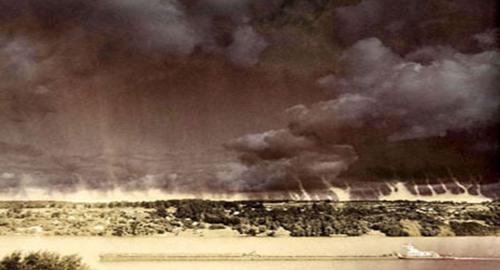TEXT4. ACID DEPOSITION
Patterns of air circulation and geography can interact to harm organisms far from the source of air pollution. In 1852, British scientist Angus Smith coined the phrase "acid rain" to describe one effect of the Industrial Revolution on the clean British countryside. In the mid 1950s, studies on clouds in the northeastern United States, farmlands in Scandinavia and lakes in England rediscovered the effects of acid deposition.
Today acid deposition in the United States originates mostly from coal-burning power plants in the Midwest that release sulfur and nitrogen oxides (S02 and N02) into the atmosphere. Gasoline and diesel fuel burned in internal combustion engines and fumes from heavy metal smelters add to the problem. In the atmosphere these oxides join water and fall over large areas as sulfuric and nitric acids (H2S04 and HN03), forming acid rain, snow, fog and dew. These acids can also return to the earth as dry particles.
Because the atmosphere contains carbon dioxide (C02) and water, all rainfall includes some carbonic acid and is therefore slightly acidic (pH about 5.6). Burned fossil fuels, however, have made the average rainfall in the eastern United States 25 to 60 times more acidic than normal. Acid deposition also affects the Pacific Northwest, the Rockies, Canada, Europe, East Asia and the former Soviet Union.
Acid deposition impacts lake life dramatically because it may lower the pH range by 3.0 to 5.0 units. The acid can leach toxic metals such as aluminum or mercury from soils and sediments. In this abnormal environment, fish eggs die or hatch to yield deformed offspring. Amphibian eggs do not hatch at all. Crustacean exo-skeletons fail to harden. In acidified lakes most aquatic invertebrates and protista die and lake-clogging mosses, fungi and algae replace aquatic flowering plants. Clinging algae out-compete photosynthetic microorganisms and coat shallow near shore areas preventing trout from spawning. Organisms that feed on the doomed species must seek alternate food sources or starve which disrupts or topples food webs. Over time these conditions reduce lake life to a few species that can tolerate increasingly acidic conditions.

The effects of acid rain on lakes are often difficult to study because of ecosystem complexity and lack of information on a lake's condition prior to acidification. In an experimental approach, since 1968 researchers in Winnipeg, Manitoba, Canada, have added sulfuric acid to a lake 200 miles (322 kilometers) southeast of the city. They have cataloged changes in the biotic, abiotic and energy components of this experimental ecosystem. In that time the lake's pH has dropped from 6.8 to 5.0.
Canada's experimentally acidified lake shows that life continues but biodiversity plummets. Before acidification the lake housed large populations of 80 species of midges, a type of insect. Today 95% of the midge community is of one previously unknown species. A formerly rare midge variant able to thrive in low pH conditions survived as natural selection removed competing species.
The Canadian experimental lake shows that acid deposition alters food webs and biogeochemical cycles but it does not seem to affect primary production, nutrient levels, and decomposition rates. Natural events also counter acidification. Calcium compounds in the earth have a buffering effect just as similar compounds do in stomach antacids. Bacteria on the needles of jack pine trees neutralize acid rain and sphagnum peat mosses ringing lakes absorb and buffer acid rain. Bacteria deep within lakes break down nitrogen and sulfur compounds. Researchers at the Canadian lake hypothesize that if pollution would stop lakes would recover in just 5 to 10 years.
Acid deposition alters forests too. In a coniferous forest high in the mountains of Fichtelgebirge, Germany, acid rain and snow thins trees and yellows needles. Here nitric and sulfuric acids trigger a cascade of effects. As soil pH drops aluminum ions percolate toward tree roots where they displace nutrients such as calcium ions (required for growth of twigs, leaves, stems, and trunks) and magnesium ions (part of chlorophyll). Loss of essential nutrients stunts tree growth. Yet the constant input of nitrogen, in nitric acid, stimulates trees to grow. These mixed environmental signals stress trees and make them less able to resist infection or to survive harsh weather. As a result acid deposition is thinning high-elevation forests throughout Europe and on the U.S. coast from New England to South Carolina.

Although smog and acid deposition still exist, air quality has improved in the United States in recent decades. The Clean Air Act, originally passed in 1970 and amended several times since, sets minimum air quality standards for many types of air pollutants. Among other provisions the law mandates reductions in sulfur and nitrogen oxides from automobiles and industrial sources such as power plants and smelters. Since 1970 emissions of nitrogen and sulfur oxides, lead, carbon monoxide, particulates and other pollutants have declined leading to significant improvements in regional air quality.
Ex.1. Answer the following questions:
- When did the phrase “acid rain” appear”?
- What is the structure of ‘acid rain”?
- Why does all rainfall include carbonic acid?
- How does acid deposition impact lake life?
- Why are the effects of acid rain on lakes difficult to study?
- How does acid deposition alter forest?
- What do you know about the Clean Air Act?
Ex.2. Give Russian equivalents for the following:
Patterns of air circulation; to harm organisms; the source of air pollution; rediscovered the effects of acid deposition; coal-burning power plants; internal combustion engines; burned fossil fuels; prevent trout from spawning; ecosystem complexity; acidification; buffering effects; to resist infection; air quality standards; air pollutants; smelters; emission; lead.